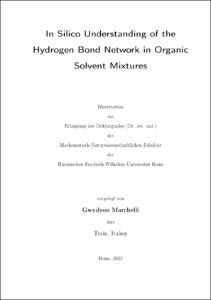In Silico Understanding of the Hydrogen Bond Network in Organic Solvent Mixtures

In Silico Understanding of the Hydrogen Bond Network in Organic Solvent Mixtures

| dc.contributor.advisor | Kirchner, Barbara | |
| dc.contributor.author | Marchelli, Gwydyon | |
| dc.date.accessioned | 2022-05-20T14:14:21Z | |
| dc.date.available | 2022-05-20T14:14:21Z | |
| dc.date.issued | 20.05.2022 | |
| dc.identifier.uri | https://hdl.handle.net/20.500.11811/9813 | |
| dc.description.abstract | In the framework of green chemistry, it is fundamental to further investigate the intermolecular interactions that define the dynamics and structure of liquids and their mixtures. Among those, the hydrogen bond in particular has a remarkable influence on the structure and properties of condensed matter. A better insight into the principles and processes that govern the hydrogen bond network will allow the design and tuning of novel sustainable solvents in the foreseeable future.
The binary quantum cluster equilibrium method (bQCE) allows to model the liquid and gas phase of both, neat systems and binary mixtures by using an ensemble of molecular clusters generated and optimized via quantum chemical methods. In this thesis, a protocol based on the bQCE theory is applied to investigate the intermolecular interactions in the condensed phase of various organic solvent mixtures. In the first part of the thesis, the mixtures of methanol with several small alcohols are studied via cluster analysis. In particular, the investigation is focused on the effect of chain length and branching over the thermodynamic properties of these mixtures. Vaporization enthalpies, activity coefficients, and combined distribution functions of the hydrogen bonds are evaluated with a combination of semi-empirical calculations and the bQCE approach. It is shown how the branching and the chain length influence the geometric features of the hydrogen bond network and how this affects the activity coefficients of the different species. Overall, a large deviation from ideality is observed when increasing the size of the alcohol; on the other hand, an increase in the branching of the alcohol leads to a more ideal mixture. In the second part of the thesis, the hydrogen bond networks of the binary mixtures of hexafluoroisopropanol with methanol and acetone are investigated using a combination of both classical molecular dynamics and bQCE. The densities of the mixtures at different temperatures are obtained from simulations and subsequently used as reference for the optimization of bQCE parameters. This removes the requirement for experimental reference data and allows the application of the bQCE method to complex systems with little to no available reference data. The bQCE theory is extended to include the temperature dependent adjustment of parameters. The structure of the hydrogen bond network is analyzed for both mixtures; their vaporization enthalpies and entropies are calculated and discussed. In both systems mixed clusters are favored even at low concentrations of hexafluoroisopropanol, and tetrameric and pentameric ring structures are strongly populated also in the neat systems. In summary, the present thesis investigates the structure and dynamics of binary organic solvent mixtures with a special focus on their hydrogen bond networks. A variety of classical and quantum chemical methods are used with a general aim for computational efficiency. This allows the application of the presented approaches to complex systems. Therefore, the results discussed in this thesis represent a starting point in the investigation of multi-component solvent systems that will be needed to develop sustainable compounds in accordance to the principles of green chemistry. | en |
| dc.language.iso | eng | |
| dc.rights | In Copyright | |
| dc.rights.uri | http://rightsstatements.org/vocab/InC/1.0/ | |
| dc.subject | Computational Chemistry | |
| dc.subject | Hydrogen Bond | |
| dc.subject | Quantum Cluster Equilibrium | |
| dc.subject | Quantum Chemistry | |
| dc.subject | Solvent Mixtures | |
| dc.subject.ddc | 530 Physik | |
| dc.subject.ddc | 540 Chemie | |
| dc.title | In Silico Understanding of the Hydrogen Bond Network in Organic Solvent Mixtures | |
| dc.type | Dissertation oder Habilitation | |
| dc.publisher.name | Universitäts- und Landesbibliothek Bonn | |
| dc.publisher.location | Bonn | |
| dc.rights.accessRights | openAccess | |
| dc.identifier.urn | https://nbn-resolving.org/urn:nbn:de:hbz:5-66085 | |
| dc.relation.doi | https://doi.org/10.1002/open.202000171 | |
| dc.relation.doi | https://doi.org/10.1002/cphc.202100620 | |
| ulbbn.pubtype | Erstveröffentlichung | |
| ulbbnediss.affiliation.name | Rheinische Friedrich-Wilhelms-Universität Bonn | |
| ulbbnediss.affiliation.location | Bonn | |
| ulbbnediss.thesis.level | Dissertation | |
| ulbbnediss.dissID | 6608 | |
| ulbbnediss.date.accepted | 08.03.2022 | |
| ulbbnediss.institute | Mathematisch-Naturwissenschaftliche Fakultät : Fachgruppe Chemie / Institut für Physikalische und Theoretische Chemie | |
| ulbbnediss.fakultaet | Mathematisch-Naturwissenschaftliche Fakultät | |
| dc.contributor.coReferee | Bredow, Thomas | |
| ulbbnediss.contributor.gnd | 1260694585 |
Files in this item
This item appears in the following Collection(s)
-
E-Dissertationen (4442)




